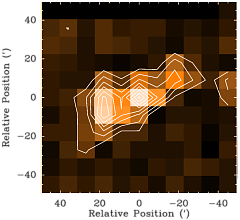Research
Compact high-velocity clouds around the Milky Way
Introduction
 High-velocity clouds (HVCs) were discovered by Muller, Oort & Raimond (1963) in the 21-cm line emission of neutral, atomic hydrogen.
They are gas clouds which are characterised by high radial velocities incompatible with a participation in the rotation of our Galaxy.
HVCs can be found all across the sky in the form of compact, isolated clouds as well as extended complexes, some of which are spanning
tens of degrees across the sky. One of the discussed hypotheses about their origin was introduced by Blitz et al. (1999) who suggested
that HVCs might represent the gaseous counterparts of the primordial dark-matter mini-haloes predicted by ΛCDM structure formation
scenarios. This suggestion was seized by Braun & Burton (1999) who identified 66 compact high-velocity clouds (CHVCs) with positional
and kinematic characteristics being compatible with a distribution across the entire Local Group.
High-velocity clouds (HVCs) were discovered by Muller, Oort & Raimond (1963) in the 21-cm line emission of neutral, atomic hydrogen.
They are gas clouds which are characterised by high radial velocities incompatible with a participation in the rotation of our Galaxy.
HVCs can be found all across the sky in the form of compact, isolated clouds as well as extended complexes, some of which are spanning
tens of degrees across the sky. One of the discussed hypotheses about their origin was introduced by Blitz et al. (1999) who suggested
that HVCs might represent the gaseous counterparts of the primordial dark-matter mini-haloes predicted by ΛCDM structure formation
scenarios. This suggestion was seized by Braun & Burton (1999) who identified 66 compact high-velocity clouds (CHVCs) with positional
and kinematic characteristics being compatible with a distribution across the entire Local Group.
Recent investigations have casted doubt on a Local Group population of CHVCs. Zwaan (2000) investigated five galaxy groups with the Arecibo telescope but he could not detect any intra-group gas clouds. A similar survey by Pisano et al. (2004) with the Parkes telescope also had a negative result indicating an upper limit of 160 kpc for the distance of CHVCs from the Galaxy. In addition, Sternberg et al. (2002) performed hydrostatic simulations of CHVCs and found their circum-galactic model with typical distances of the CHVCs from the Galaxy of about 150 kpc to be more consistent with the observed properties of the CHVCs. Similar results are obtained by Kravtsov, Gnedin & Klypin (2004).
Our Effelsberg observations of CHVCs
To investigate the properties of CHVCs in more detail, we observed a larger sample of 11 CHVCs in H i with the 100-m radio telescope at Effelsberg. The most outstanding result of our observations is the complexity of the H i column density distribution and the line profiles of the investigated CHVCs. We found only one cloud with a spherically-symmetric appearance. Among the remaining clouds we observe head-tail structures, bow-shock shapes, and objects with irregular shapes. These complex morphologies in combination with the obtained physical parameters suggest that ram-pressure interactions with an ambient medium may play a significant role in shaping some of the CHVCs from our sample. These results are consistent with a circumgalactic distribution of CHVCs with typical distances of the order of 100 kpc, where the gas of an extended Galactic corona might provide the necessary particle densities to account for the observed effects. The pressure of the ambient medium might also stabilise CHVCs in addition to their own gravitational potential.
Publications for further reading
- Effelsberg H i observations of compact high-velocity clouds
Westmeier, T., Brüns, C. & Kerp, J. 2005, A&A, 432, 937
(astro-ph/0502011) - H i observations of an ultra-compact high-velocity cloud
Brüns, C. & Westmeier, T. 2004, A&A, 426, L9
(astro-ph/0409153)